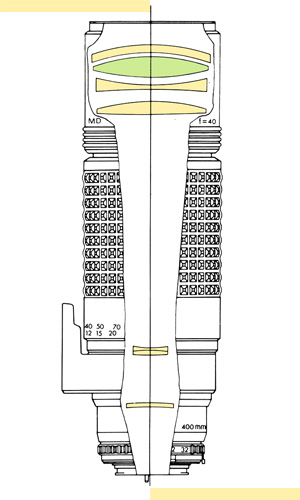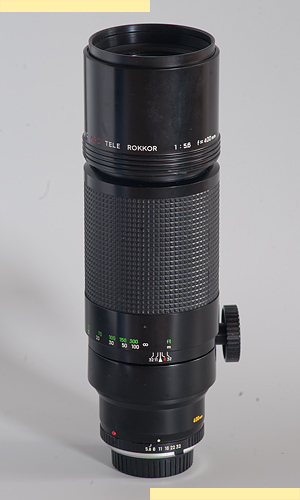Das Minolta MC 5.6/400 mm von 1976 war das erste apochromatisch korrigierte Teleobjektiv von Minolta - und gleichzeitig das erste mit einer Fluorit-Linse. Seine Abbildungsleistung ist exzellent, doch leider hatte Minolta im Bereich der langen Teleobjektive den Trend hin zu lichtstarken f2.8-Teles komplett verpasst, den Topcon mit einem damals exotischen 2.8/300mm bereits in den 1960er Jahren vorgespurt hatte; Nikon und Canon folgten ab 1972 mit ihren apochromatischen 2.8/300 mm-Objektiven. Möglicherweise hatte Minolta schlicht Mühe, Fluoritkristalle in der für ein 2.8/300mm notwendigen Grösse zu züchten - und ein Glas mit anomaler Teildispersion (AD-Glas) war bei Minolta erst zur Zeit der ersten Autofokus-SLRs verfügbar. Von einem manuell fokussierbaren 2.8/400 mm, wie es sowohl Canon als auch Leica um 1990 herum anboten, konnte man bei Minolta nur träumen...
Die weiche und kratzanfällige Fluorit-Linse liegt beim MC/MD 5.6/400 mm gut geschützt hinter einer ersten Linse aus Glas verbaut.
 |
 |
MINOLTA 400mm 1:5.6 APO (7 Linsen / 6 Glieder)
Fassungen: MC-X (1976), MD-I (1977), MD-II (1977), MD-III (1982)
(MC 5.6/400mm APO aus der Sammlung G. Ehlers) |
"Die 400er enthalten eine Fluorit-Linse, gelten als höllenscharf (ich hab mit meinem aber offenbar Pech gehabt), und sind teuer. In der deutschen E-Bucht tauchen ab und zu welche auf (mindestens eins, aber weniger als fünf im Jahr). Es sind seltene Objektive mit einem guten Ruf - und daher sind sie teuer. Ab 350 EUR aufwärts. Aus freier Hand erscheint es mir als nicht benutzbar."
ChristophPeterS
"Das Apo Tele Rokkor 1:5,6/400 mm hingegen wird man kaum für unter 600 Euro bekommen, einerlei ob MC oder MD ... für ein sehr gut erhaltenes Exemplar kann der Preis auch auf 800 oder 900 Euro steigen. Es ist halt selten, und bei seltenen Dingen können die tatsächlich gezahlten Preise stark schwanken." O1af
...habe das MD ApoTele Rokkor 5,6/400mm mit Apo Konverter vor ein paar Monaten für 450 Euro ersteigern können. Für mich ein sehr guter Preis. Das Objektiv kann schon bei offener Blende überzeugen; auch mit dem Apo-Konverter bei 1 Stufe Abblendung. Selbst mit zwei Konvertern (Apo + 300S = 1600mm) und entsprechender Abblendung sind die Ergebnisse noch sehr gut.
SRM (www.mi-fo.de)
"Now, when I have told all the drawbacks, why should you bother with this lens? Its strong points are the optical quality that exceeds the third-party counterparts, and a matched 2x teleconverter that maintains the quality excellently. It is extremely well made, as you could expect from a Minolta lens of the late MC era, and not overwhelmingly weighty like the fast lenses of this focal length. If the 400/5.6 is the focal length/speed combination you decide you need, this is most likely optically the best option. ... I personally used this lens mostly for photographing waterbirds during the spring, when they arrive from the south and look (and fight) for suitable nesting sites. There is lots of light available, the environment is open and distances sometimes huge: the water, many times covered by weakened ice, isolates you very effectively from your subjects. Many times it is impossible to move closer, even if you wanted to carry a hide to some piece of land close to the birds. The rest of the year the lens stayed home - it is too slow and unpractical, and I preferred the slightly shorter, a bit faster and much lighter and easier to handle MD Tele Rokkor 300mm f4.5 IF. The lens has a fixed hood (too short, as usual) and a sturdy tripod collar, both necessary. The filter diameter is 72 mm. The original leather case is well done and has a separate room for the 2x converter."
www.geocities.com/mikkonis/reviewed/md400mm.html

